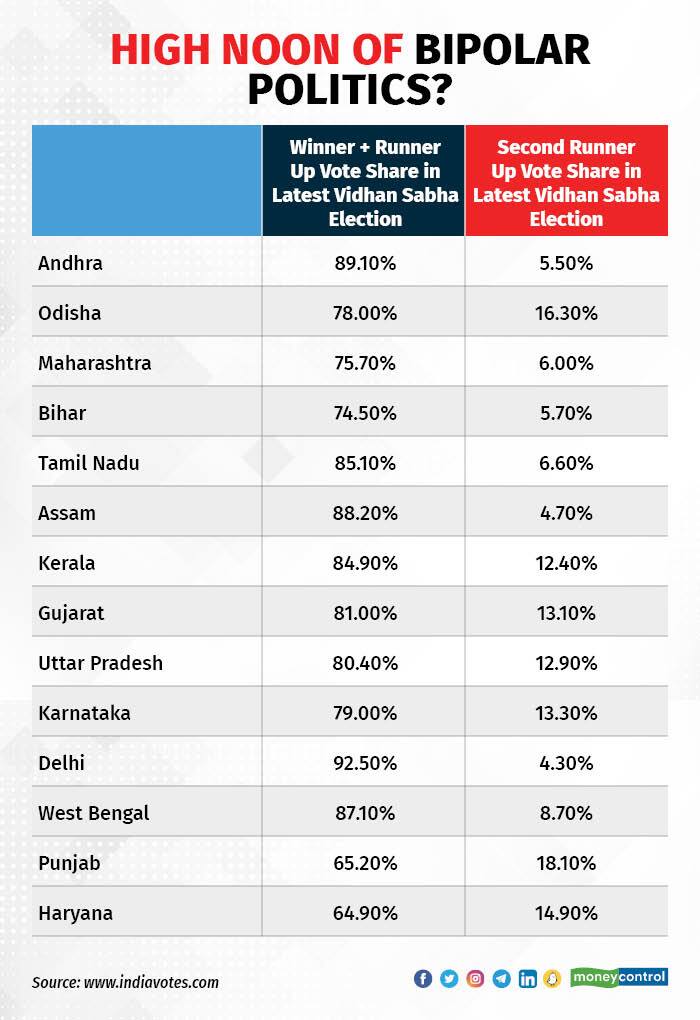



The poor performance of Janata Dal (Secular) in Karnataka, its worst in the last two decades, poses significant existential risks for Gowdas in a state where they have been kingmakers for quite some time. It has larger ramifications for the idea of the “Third Front” at the state level as electoral contests are becoming increasingly bipolar.
The JD(S) Flop ShowWhy did JD(S) perform so poorly? This is primarily because:
* Large section of its voters – mainly Dalits, Muslims and OBCs – didn’t feel it had the firepower to beat the BJP. They switched to Congress, which appeared the better alternative
* Some voters may have felt that voting for JD(S) could have led to a hung assembly situation and created instability
* As soon as Congress created an alternative Vokkaliga leadership in DK Shivakumar, JD(S) core voters too slipped and moved to Congress (+8 percent as per AxisMyIndia exit poll)
It appears that the contest turned from triangular to bipolar with Congress and BJP occupying the media space and voters' minds with JD(S) knocked out of the electoral chatter.
The Diminishing Third ForceIn such a scenario, the vote share of the third player is usurped by the dominant forces, the winner and runner-up, in line with their social coalitions.
In state after state, the third player is getting squeezed out. In many states the third force and other smaller forces are aligning with the winner or the runner up for their political survival.
In an increasingly bipolar scenario in a polarized environment the third player in states is getting marginalised. Generally a contest is considered as triangular when all the three parties get a vote share of more than/equal to 20 percent.

In Andhra, the main contest is between YSRCP and TDP, with Jana Sena Party a marginal player. In Odisha, it’s a BJD versus BJP fight with Congress reduced to a player with less than 10 seats.
In Maharashtra most parties are either aligned with NDA or MVA. The third largest party Prakash Ambedkar’s VBA has aligned with the Uddhav faction of Shiv Sena. In a similar situation in Bihar, the Chirag Paswan faction of the LJP is the third force, and is most likely to join NDA.
In Tamil Nadu and Assam, most political forces are either in UPA or NDA. In Kerala, BJP is the third player but doesn’t have even a single MLA or MP from the state.
In Gujarat, AAP has emerged as the third force, but could win only five seats. If it gets further stronger it is likely to be at the cost of Congress. But a bipolar contest scenario is likely to continue.
In Uttar Pradesh in 2022, Mayawati’s BSP was reduced to a mere one seat, paving the way for a BJP vs SP contest. Muslims, OBCs, Jatav Dalit voters of BSP moved to SP and BJP. Post results, Mayawati blamed the media for making it a bipolar contest.
In Delhi, Congress has been reduced to a non-entity with almost its entire vote base shifting to the AAP.
In West Bengal, the Left and Congress Mahajot were routed, failing to win a single seat in a BJP vs Mamata contest.
In Punjab, the Badals’ Akali Dal was severely dented as AAP took centrestage reducing it to less than five seats. Haryana is the only big state, sending ten or more than 10 MPs to Parliament, which threw a hung verdict in 2019. But JJP, the third player then, is now in NDA.
The space for a third front in state level politics across India is shrinking day by day. This “third front” is not one party across the nation, it is different parties in different states. In some states it is the BJP (Kerala), other it is the Congress (Delhi), and in rest of the states some or the other regional party.
Amitabh Tiwari is a former corporate and investment banker-turned political strategist and commentator. Twitter: @politicalbaaba. Views are personal and do not represent the stand of this publication.Discover the latest Business News, Sensex, and Nifty updates. Obtain Personal Finance insights, tax queries, and expert opinions on Moneycontrol or download the Moneycontrol App to stay updated!
Find the best of Al News in one place, specially curated for you every weekend.
Stay on top of the latest tech trends and biggest startup news.